

 The South African
The South African
Otherwise known as Tipu Sultan of Mysore, Fateh Ali Kahn experienced continuous warfare from the age of thirteen until his death at the age of 48. He was, nonetheless, a great builder and even pioneered a banking system as well as military rocket technology. Having inflicted terrible losses on the British colonialists and their allies over many years, Tipu Sultan was eventually killed in conflict against forces under the command of Lord Wellesley, Governor-General of British India, who had gathered the largest British Army in India until that time. By the end of four wars, Mysore had earned a reputation as the 'terror of Leadenhall Street' (headquarters of the East India Company). In modern India, Tipu Sultan is hailed as a martyr. He destroyed the myth of British military invincibility, retained the ideal of a united India, and still managed to develop the economy and infrastructure of Mysore while fighting constant wars.
About the Author
Dr Syed Mohammad Amir holds a PhD in History and is a scholar of history and literature, studied at Aligarh Muslim University, Aligarh, where he specialises in the military aspect of modern Indian history. He has conducted extensive research on military technology and modernisation trends under Tipu Sultan (1782-1799). He has published numerous research papers in national and international journals and proceedings dealing with different aspects of Indian military history and culture. He is actively associated with academic organisations like the Indian History Congress, the UP History Congress and the Rajasthan History Congress. He is presently engaged in translating Persian and Urdu manuscripts for publication and is currently associated with Jamia's Premchand Archives & Literary Centre, Jamia Millia Islamia, New Delhi, India.
INTRODUCTION
Tipu Sultan (Fateh Ali Khan), the ruler of Mysore from 1782 until his death in 1799, displayed brilliant military skill in war on the Indian sub-continent during the eighteenth century. As a leader in war, he stood like a giant. He is portrayed in the chronicles as a tiger fighting the British lion. He was one of the most powerful opponents of British colonialism among the Asian Powers. His name was whispered with awe in the Indian courts and with dread in the British council chamber. The rafters of the House of Commons trembled when Edmund Burke thundered about the might and the power of the ruler of Seringapatam. His rise to power was very rapid and astonishing. A ruling prince, who personally led his army (Lashkar-i-Khudadad) into battle, was not unusual. The Mughal Emperors, Babur (1526-1530) and Akbar (15561605) had done so. The Rajput Kings considered it an honour to be the first in the firing line. Shivaji was a soldier king and his example was followed by Baji Rao I and Mahadji Scindia. In Tipu's own generation, however, the rulers of the Indian Principalities were not distinguished military leaders. Nana Saheb and Baji Rao II at Poona, the Nizam at Hyderabad, Mohd Ali at the Carnatic, and the Raja of Travancore were only political commanders. Their armies fought against Haider and Tipu, but they, themselves, remained within the safety of their palace walls.
Tipu, with the blood of Hyder Ali Khan Nawab Bahadur (1761-1782) coursing through his veins, was his own commander-in-chief (F Denys, 1970, pp 138-41). He was an able and gallant soldier. As a tactician, he had no match during his period. In war, he himself commanded the principal army. His personal valour, fearlessness in danger and perseverance inspired his troops with confidence and enthusiasm. Owing to this, he was extremely popular with his army. His energy and activity were bewildering. His development of tactics was a matter of amazement and terror to all who ventured against him on the battlefield. The dread of his arms and army spread everywhere and he marched almost unhindered from battle to battle and victory to victory.
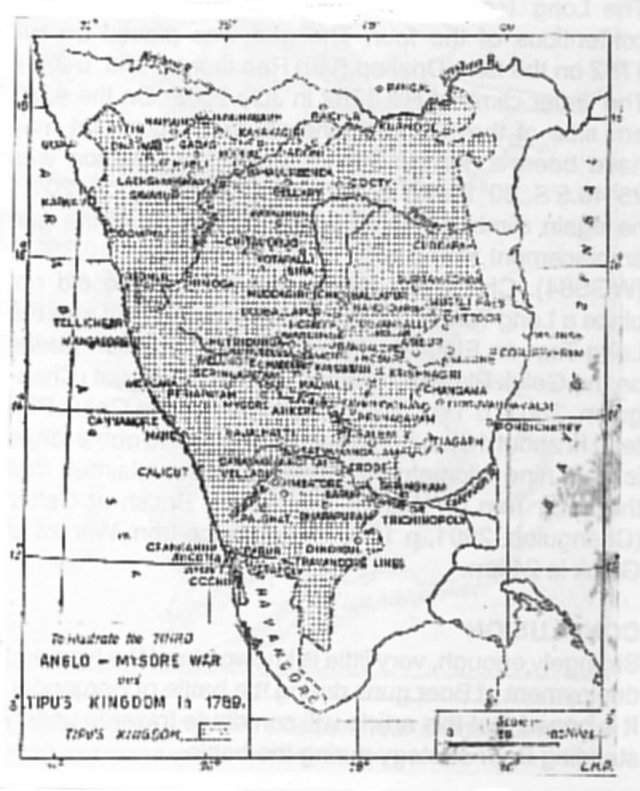
TIPU'S MAXIMS OF WAR
Even Major J Runnell, a British officer who was very hostile to the Sultan, admitted that his adversary possessed great qualities of 'war and finance' (J Runnell, 1792, p xxxix). Tipu Sultan devised many strategies and tactics of war during the course of his leadership, as is exemplified in Fath-ul-Mujahidin (Victory of Holy Warriors) written by Mir Zain-ul-Abidin Shustari. In spite of Shustari's own high rank of Siphadar (general) and being the Mir Munshi of Tipu Sultan in the Mysorean Army (Lashkar-iKhudadad), he knew the use of the pen better than the use of the sword. He wrote this work at the Sultan's request under his direct supervision and partly at his dictation in 1783. Its importance lies in the fact that it is the only contemporary work in Persian that deals with Tipu's military administration (Nizam-i-Fauj) and tactics of war (Tadabir-i-Harb). It is a well-documented study in which the author, who knew Tipu personally, did his best to project his leader's military abilities in the correct historical perspective. This rare document has an introduction and eight chapters on Tipu's military maxims (Usool-i-Fauj) and tactics of war, some of which will be summarised below.
It is worth mentioning here that numerous copies of Fath-ul-Mujahidin are still available in manuscript form in many of the famous libraries of the world. The India Office Library alone possesses 22 copies, 21 of which are complete. Apart from the India Office Library, many other libraries possess this book. The following libraries may be particularly mentioned: the British Museum, the Bodleian in Oxford, the Royal Asiatic Society of Bengal in Calcutta, the Kutubkhana-i-Asfaia and Daftar-i-Diwani or the Records Office in Hyderabad Deccan. Many private libraries, particularly in South India, possess this book, some of which were copied during the time of Tipu Sultan. There is one such copy nicely preserved in the Habibganj Collection in the Maulana Azad Library at Aligarh Muslim University, Aligarh (Khan, 1971, P 405; also cited in Habib Irfan, 1999, p xxxvi).
Unity of Command
All military philosophers from Sun Tzu to Clausewitz emphasize that unity of command is a prerequisite for victory. It is important to note that Tipu Sultan also enjoyed the great advantage of an undivided command. Owing to his personal direction of the campaign, his commanders could not give expression to their mutual jealousies. All forces of the Sultan's Sarkar-i-Khudadad* (literally meaning 'God-given government') were well disciplined, well trained and well paid and their morale was high. His regular horses under Ghazi Khan, Wali Mohammad and Ibrahim Khan proved very effective in harassing the enemy and cutting off their supplies.
Illustrations in this article:
Encampment charts of Tipu's Army (Lashkar-i-Khudadad) during the course of war with the British (There were seven patterns of encampment drawn up under the Sultan's guidance)
Source: Journal of Pakistan History Society, Vol IV, No 1, 1956, Karachi, (pp 1-2), Centre of Advanced Study, Department of History, Aligarh Muslim University, Aligarh.
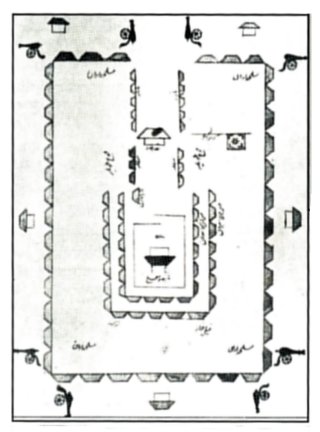
Intelligence and planning
Sultan Tipu's general plan of a campaign was always sound. The manner of fighting was defensive rather than offensive. In the Fath-ul-Mujahidin, he recommends that, before hostilities commence and an offensive is launched, a reconnaissance should be made of the battlefield, examining it thoroughly and finding out if the enemy forces have entrenched themselves behind clusters of trees or under the shelter of a mountain or at the bank of a river. Should any of these conditions exist, he advises against waging war, except in a situation where war has become inevitable and the shelter or the enemy forces are on one flank (Shustari, Mir Zain-ul-Abidin, 1346/1783, p 27). Under such circumstances, the cavalry should be dispatched to reduce the enemy's ability to fight back, while the main force gains proximity to the enemy position. Once this goal has been reached, the cannons should be fired, followed by gun-fire and small arms fire (banadiq). In the event that the enemy forces are positioned advantageously on even ground, the army should be divided into three equal lines and, after the cannonade and gun fire, they should pounce upon the enemy with spears and daggers (Shustari, Mir Zain-ulAbidin, 1346/1783, p 27).
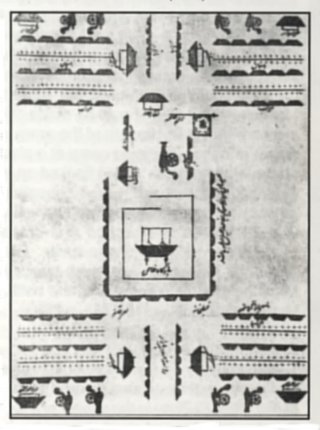
Night attack
Sultan Tipu advises that, if the army of the enemy is found to be the stronger, fighting should be stopped in favour of guerrilla warfare. Typically, one should bring the artillery face to face with the enemy forces and start the battle with a bayonet attack, with horse riders observing the enemy army from a distance. The horse riders should bring news of enemy movements and, when it becomes clear that the enemy intends to attack, a retreat should be made under the cover of a cannonade. As soon as the enemy stands up, the Sultan's army should do likewise and use their artillery (Autish-Khana) (Shustari, Mir Zain-ul-Abidin, 1346/1783, p 27). When the enemy forces get ready to fight and arrive on the battlefield, the best recourse is a night attack. In this type of attack, one should wait for the enemy forces to approach and for the last quarter of the night, before moving so stealthily and secretly with light artillery that even the sound of the horses and the movement of the infantry are not heard. The soldiers should keep quiet and pounce upon the enemy and penetrate his line, firing with guns (Tufung) and cannons (Darakhsh). Under no circumstances should the soldiers be allowed to lay their hands on the enemy's valuables during the attack, as it has been proven by experience that when soldiers, out of greed and avarice for riches, turn their attention to plunder and looting, they become indifferent to the fighting, giving the enemy an opportunity to rally and remobilize (Shustari, Mir Zain-ul-Abidin, 1346/1783, p 27).
When facing a weaker enemy, the army should aim to capture the enemy's artillery. After a successful night attack, the enemy's camp should be firmly held until the middle of the following day. The army should not be dispersed in the morning. When the enemy forces disperse, they should be observed by horsemen who should communicate all details regarding the enemy to their officers. The army should be stationed at a place that is inaccessible to the enemy.
However, if the enemy forces are greater in number after a night attack, the army should take to the opposite direction and dismount at a distance of two or three miles (3-5km) at a fortified position at the foot of a mountain or in a forest, disarm itself and remain there for the whole day (Shustairi, Mir Zain-ul-Abidin, 1346/1783, p 28). At nightfall, a new start should be made. Whenever there is a change in the strength of the army, whether in time of war or peace, it should camp at a place where it faces the enemy forces and is flanked on either side by a mountain or forest and river, irrespective of the amount of water or any other consideration. Even if the army is outnumbered or stationed in a precarious position, it should never demonstrate haste. Battle should be based on the cannon, and such tactics be deployed to force the enemy to come onto the battlefield (Shustari, Mir Zain-ul-Abidin, 1346/1783, p 28).
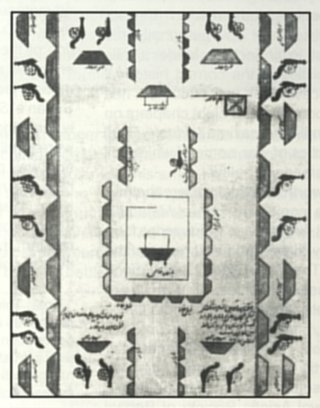
Engaging the enemy
If the enemy does not deliberately start hostilities before evening, then its army should be kept at a distance of two miles (3,2km) in the shelter of a well-known place. Cavalry, infantry and musketeers should be posted to guard access routes and, should the enemy get out and make good his escape, the army should be re-armed to pursue the enemy and engage him using musketeers and cannons hidden at strategic points (Shustari, Mir Zain-ul-Abidin, 1346/1783, p 28).
Tipu Sultan wisely suggests that the cavalry should be posted in advance to disrupt and cripple the advancement of the enemy and scuttle his every effort to launch an offensive until the main forces arrive. During the battle, the infantry (Yazakdar) should be deployed on the right and left wings to defend their camps. While camping, half of the army should form the vanguard and the other half the rear-guard. Two pairs of mounted soldiers at the front and rear of the army should keep vigil around the clock (Shustari, Mir Zain-ul-Abidin, 1346/1783, p 28). When marching to war, even when the enemy is at some distance, every effort should be made to keep both wings of the army alongside or in the midst of dense trees or in the shelter of a river. If battle ensues on the way, these defences should be used. By using these tactics, commanders have managed to pierce through an armed force ten times their own size, succeeded in sending food and reinforcements wherever it was needed, and then returned to their station by the same route and method (Shustari, Mir Zain-ulAbidin, 1346/1783, p 28).
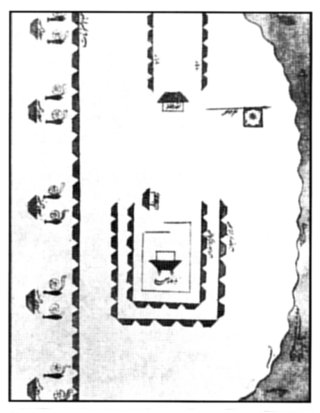
Command
All the commanders and sipahdars (commandants) should be posted as premeditated. The cannons should precede the risala (an Arabic word meaning 'troop of horses', sometimes used more generally to refer to cavalry or infantry troops/squadrons). The boxes of gunpowder are left behind the army and observant horse riders are sent to the battlefield to examine the nature of the land. The enemy should also be watched to ensure that, in the event of battle, the commander is able to organise his soldiers and artillery appropriately (Shustari, Mir Zain-ul-Abidin, 1346/1783, p 29). The commander-in-chief should warn the soldiers that anyone found shirking his duty or showing his back during the course of the battle will be killed without hesitation. If the Risaldar collides with the enemy, he should be killed (Shustari, Mir Zain-ul-Abidin, 1346/1783, p 29).
If the enemy stands, stand yourself and begin the cannonade. If he tries to come forward, retreat slowly, fighting. If it is proven that Sipahdar (commandant) did not act according to the rules, or that he ran away to save his life, or left his cannons to the enemy, then his punishment is to be hanged until death, before rich and poor. If he acted according to the rules, he should be given jagirs, horses and elephants (Shustari, Mir Zain-ul-Abidin, 1346/1783, p 29). When the appointment of Sipahdar is confirmed, then all should obey him and if someone acts against his wish, he has the right to punish him.
When facing a stronger enemy, the army should remain behind clusters of trees or under the shelter of a fort or in a secure position and build up strength, becoming more formidable each day. By launching repeated attacks on the enemy and then withdrawing to a safe position two or three miles away, the soldiers will gain strength and boldness, while the indifference of the enemy will grow (Shustari, Mir Zain-ul-Abidin, 1346/1783, p 29).
Sardar or Sipehsalar (the commander-in-chief) should also send reporters to collect more information of the situation about ten or twenty miles (16-32km) away, and note the location of water and clusters of trees, so that, in times of need, these can be used. The movement of the enemy's forces should also be carefully monitored. When the army is on the march, horsemen should be posted in the front and the rear as an advanced guard and rearguard some distance from the main army. It is important never to begin the war of cannons, rather let the enemy start, and use every opportunity to disrupt and scuttle his plans before starting a cannonade (Shustari, Mir Zain-ul-Abidin, 1346/1783, p 29).
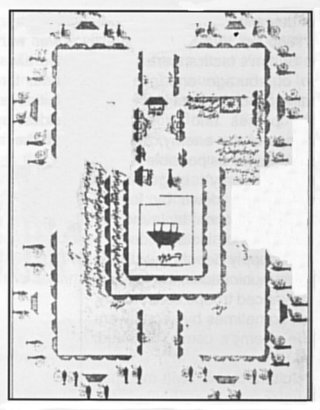
The attack
When the enemy forces are within range, cannon shells should be fired. If the enemy is closer, then gunfire should be used and, if at point-blank range, then the army should advance with the invocation, 'Oh! Allah help us!' and thus make the life of the enemy impossible (Shustari, Mir Zain-ul-Abidin, 1346/1783, p 29). If guerrilla warfare breaks out, the artillery should be left at its place and, under the cover of cannons, a retreat should be made. It has been said that war is deception (Stratagem) (Shustari, Mir Zain-ul-Abidin, 1346/1783, p 30). According to the Chinese military theoretician, Sun Tzu, 500BC, all warfare is based on deception. He further suggests that if the enemy is stronger and he has stationed himself in the centre of his army (Qalb) and wants to go to a safer place, attack after 02.00 or 03.00 at night, when the enemy becomes indifferent and assumes that there will be no attack and the men retire to refresh and relax. By attacking at that time, the goal should be reached and the enemy placed at a disadvantage. If he stays near the camps, a night attack would be an easy thing (Shustari, Mir Zain-ul-Abidin, 1346/1783, p 30). The role of the horsemen in the front and rear of the main army is to clash first with the enemy, thereby protecting the main force (Shustari, Mir Zain-ul-Abidin, 1346/1783, p 30).
All of the principles of warfare described above have been developed through experience and have many advantages. When attacking a fortified position, the aim must be to capture the position by, firstly, destroying the cannons on the towers with a precise cannonade and then assaulting the walls (Shustari, Mir Zain-ul-Abidin, 1346/1783, p 31).
War and politics against the British colonialists and their allies
Because of his strategies and tactics of war, Tipu Sultan, in various bloody encounters, taught the British that he was no stranger to a combination of military art and exploits of valour. He thus combined clever political expedience with war tactics. He incited hatred against the British, adhering to the maxim that everything is fair in war, and was proclaimed the saviour and avenger of Mysore. He drew, from all parts of India, new lessons in the art of destruction and enveloped himself in a heavy cloud of desolation and carnage (Michaud, 1885, pp 38-39). Tipu Sultan's tactics were a combination of courage and planning. His main principle was to attack detached parties and to intercept the convoys of the enemy, avoiding open battle as far as possible. When invading an enemy's kingdom, he wore the enemy down by forcing him into long marches, by launching surprise attacks on isolated detachments and supply depots, by cutting off his communications, by harassing his advanced troops ceaselessly, and even sometimes by secretly entering the enemy's camp (Michaud, 1885, pp 65).
The Sultan, by his swift marches and counter-marches, baffled the English commanders who toiled in vain to catch up with him. He inflicted great loss on their armies, both in terms of men and material, and he not only disrupted Meadow's plans for the invasion of Mysore but also invaded the Carnatic, thus converting a defensive war into an offensive one.
He definitely proved his superiority as a skilful general and as a tactician of the highest order. Even the Governor-General, Lord Cornwallis, who did not like to admit the defeats that the English armies had sustained during the Third Anglo-Mysore War, 1790-92, acknowledged that 'we have lost time and our adversary has gained reputations, which are the two most valuable things of war' (Ross, 1859, p 51). Through the improvements that he introduced to his infantry and artillery and, above all, his cavalry, thei Governor-General was obliged to admit that 'Tipu's Looties were the best troops in the world, for they were always doing something to harass their enemies' (Gleig, 1830, p 133). According to Arthur Wellesley, Tipu's cavalry was the best of its kind in the world (Owen, 1880, p 63).
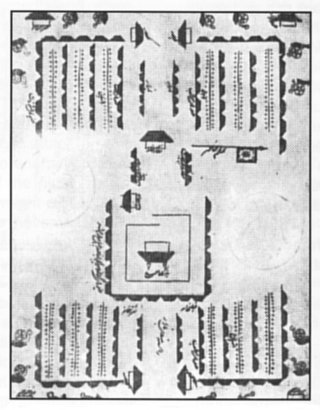
It is important to mention here that the Sultan crossed the Tungabhadra River with his army while it was in flood and inflicted severe defeats upon his enemies in a series of night attacks which wore them down and obliged them to listen to his overtures of peace. He kept close to the riverbanks, which were steep and rocky, difficult terrain for the movement of the enemy cavalry, but favourable to the operations of his infantry. This proved decisive in the war with the Marathas and Nizam. He always selected his own ground and, throughout the campaign, the initiative remained in his hand. Besides, by marching along the banks of the river, Tipu was well placed to draw supplies from his kingdom, south of the river. In addition, Tipu's efficient intelligence service enabled his irregular horse to intercept the Maratha's convoys; the shortage of supplies being in no small measure responsible for the enemy's reverses in this war (Khan, 1971, p 109).
Tipu has often been criticized for allowing the decline of the cavalry and for giving up his father's mode of warfare (Fortescus, Volume 4, Part II, p 745). Although he began to make increasing use of his infantry, he did not give up Haider's mode of warfare. In fact, it was because both his infantry and the cavalry played their distinctive and proper roles, that he was able to defeat the Marathas-Nizam coalition and to carry on a gallant struggle for nearly two years against an Anglo-Nizam-Maratha confederacy. In his war with the Maratha, when victory was due mainly to his superior infantry and artillery, the cavalry too rendered valuable assistance by harassing the enemy and cutting off their supplies (Khan, 1971, p 385, also cited in Roy Kaushik, 2004, pp 113-9). Tipu Sultan's success against the English commanders Meadows, Floyd, Maxwell and Braithwaite was entirely due to the efficient use of his cavalry, which afforded him superior mobility. When Lord Cornwallis advanced on Seringapatnam in May 1791, it was the co-ordination of the Mysore cavalry and infantry that checked his further advance and forced him to retreat from Arikere. Tipu's infantry offered such stubborn resistance before the capital that the Governor-General was compelled to make peace (Khan, 1971, p 385).
During the course of a war, Tipu himself commanded the principal army and his generals, whom he sent to fight on different fronts, had to act according to his instructions (Khan, 1971, p 330). Major Dirom (1794, p 249) writes that Tipu was a brave and intrepid general and describes the restless enterprising spirit of the Sultan with admiration. He also testifies to the fidelity of the Mysore troops to Tipu. Even Colonel Wilks (1930, p 762) admits that the army remained loyal to the Sultan until the end. He left the world much changed upon his exit at the end of the Fourth Anglo-Mysore War on 4 May 1799.
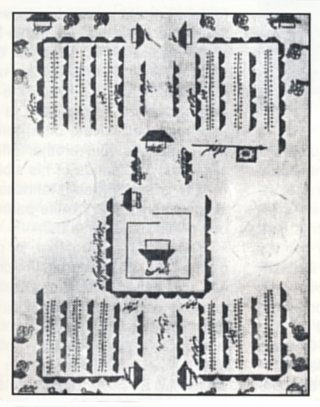
Conclusion
All the historical writing reveals that Tipu Sultan was undoubtedly the most innovative strategist and craftiest tactician of his time in eighteenth century India. Prof Mushirul Hasan (2003, p 54) rightly suggests that 'what is ... required is a cool and dispassionate analysis of Tipu's actions in the context of the turbulent decades of the 18th century in South India and the Sub-Continent generally'. Mohammad Mustafa Khan (Khan, 1844, pp 258-9) writes that Tipu was a unique personality in India, resembling Nadir Shah of Persia and second only to Tamuchin of China (Chinggis Khan). He further opines that Mother-Earth will not be able to produce such a Rustam-like hero for another 200 years.
It is an admitted fact that, from 1767 to 1769, the British fought the first of a series of evenly contested wars against Mysore State, whose mighty rulers, Haider Ali and Tipu Sultan, were clearly military organ isers of a very high order. Even in First Anglo-Mysore War, the Mysore artillery was said to be equal, if not superior, to that of their enemy and that they exceeded them in quickness of firing.
Again, in the Third Anglo-Mysore War, 1791-2, Tipu Sultan fought with great courage, hitting hard and sometimes very hard during Lord Cornwallis's advance on Seringapatam in May 1791. The Sultan displayed brilliant strategy by destroying the British baggage and by laying waste the country through which they marched. Tipu's cavalry wore them off and, before Seringapatam, he fought with great courage like a tiger and defended his capital in a manner truly worthy of his father, himself, and his nation.
It is one of the greatest tragedies of the nation that this monumental military strategist was brought to an end so early by the colonial authorities. Undoubtedly, the resistance given by Haider Ali and Tipu Sultan had no parallel in history during the second half of the eighteenth century. The British hit back again and again until they destroyed Tipu and erased all trace of what he had achieved in Mysore, even from the memory of the people, perhaps threatened by Tipu Sahib's modern mind, scientific temper and war-like spirit.
In summary, Kirmani writes that this was undoubtedly a twist of fate, under the power and control of no one: 'In short, the agents of fate and destiny did what they willed or what was in their power' (Khan, 1844, p 273; see also Hasan, 1956, pp 56-7). Shama Rao, author of the celebrated book, Modern Mysore, confirms this view that the Sultan's military abilities were beyond question, but that the outcome of the Fourth Anglo-Mysore War in 1799 was predetermined by fate (Shama Rao, 1936, p 194; 1939, p 511).
In conclusion, one can only say that whereas the Bourbons learned nothing but forgot nothing, the Indian rulers learned nothing but forgot everything and did not come forward to help Tipu. On 4 May 1799, a storming party crossed the breach and, after several hours of fierce hand-to-hand fighting, captured Tipu's capital. Amid a heap of dead and wounded soldiers, Tipu's body was found, still warm, with eyes open and sword in hand. He had three bayonet wounds and a musket shot to the head (Zubrzycki, 2006, pp 49-50).
Seringapatnam was given over to reckless rapine and slaughter by the victorious army after the death of the Sultan. The only thing that was done witn grace was Tipu's funeral, with military honours, perhaps to prove to everyone that he was indeed dead and to prevent any further resistance (Habib Irfan, 1999, p xli). An English observer present on this occasion wrote that, even as the victors were plundering their houses and property, the people of Seringapatnam lined the streets through which the funeral procession passed, and that many 'prostrated themselves before the Sultan's body, and expressed their grief by loud lamentations' (Beatson, 1800, p 148). That was how his own people felt about the Sultan more than two hundred years ago.
Bibliography
Denys, Forest, Tipu's Tiger - The Life and Death of Tipu Sultan (Bombay, 1970)
Runnell, J, Marches of the British Armies in India during the campaigns of 1790 and 1791 (London, 1792)
Khan, Mohibbul Hasan, History of Tipu Sultan (Calcutta, 1971)
Habib Irfan, Confronting Colonialism: Resistance and Modernization under Haider Ali & Tipu Sultan (Tulika, New Delhi, 1999)
Kabir Kausar (translated), Secret Correspondence of Tipu Sultan (Delhi, 1998)
Shustari, Mir Zain-ul-Abidin, Fath-ul-Mujahidin (Mysore, 1346/1783. Note: There is a Mss copy in Maulana Azad Library, Habibganj collection, AMU, Aligarh)
Michaud, Joseph, History of Mysore under Haider Ali and Tipu Sultan (New Delhi, 1885)
Ross, C, Correspondence of Charles, First Marquis Cornwallis, Volume 2 (London, 1859)
Gleig, G R, The Life of Sir Thomas Munro, Volume1 (London, 1830)
Owen, S J A, Selection from the dispatches relating to India of the Duke of Wellington (Oxford, 1880)
Fortescus, Volume 4, Part II, p 745
Kaushik, Roy, India's Historic Battles from Alexander the Great to Kargil (Delhi, 2004)
Dirom, Major, A Narrative of the campaign in India, which terminated the war with Tipu Sultan in 1872 (London 1794)
Wilks, M, Historical Sketches of South of India in an attempt to trace the history of Mysore, Volume 2 (Mysore, 1930)
Mushirul, Hasan, Making Sense of History: Society, Culture, and Politics (Delhi, 2003)
Kirmani, Meer Hussein Ali Khan, The History of the Reign of Tipu Sultan, Being a Continuation of the Nishan-i-Hyduri (translated, W Miles, London, 1844)
Askari Syed Hasan, Some Letters of, and Relating to, Tipu Sultan (Proceedings of the Indian Historical Records Commission, Volume 32, 1956)
Shama Rao, Modern Mysore, from the beginning to 1868 (Bangalore, 1936)
Mahmood Khan Mahmood, Tarikh-i-Sultanat-i-Khudadad (Bangalore, 1939)
Zubrzycki, John, The Last Nizam: The rise and fall of India's greatest princely states (Picador, London, 2006)
Habib Irfan, Confronting Colonialism: Resistance and Modernization under Haider Afi and Tipu Sultan (Tulika, New Delhi, 1999)
Beatson, Alexander, A View of the Origin and Conduct of the War with Tippoo Sultan (London, 1800)
Return to Journal Index OR Society's Home page
South African Military History Society / scribe@samilitaryhistory.org